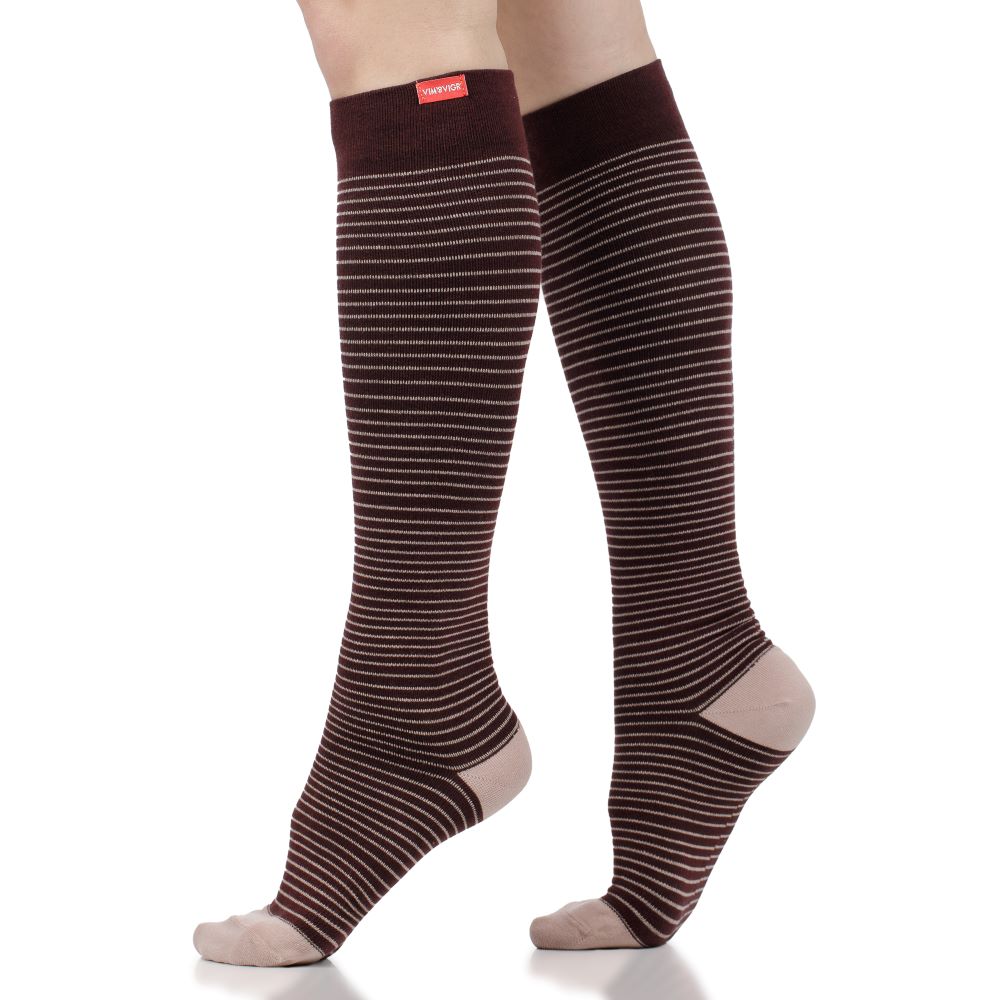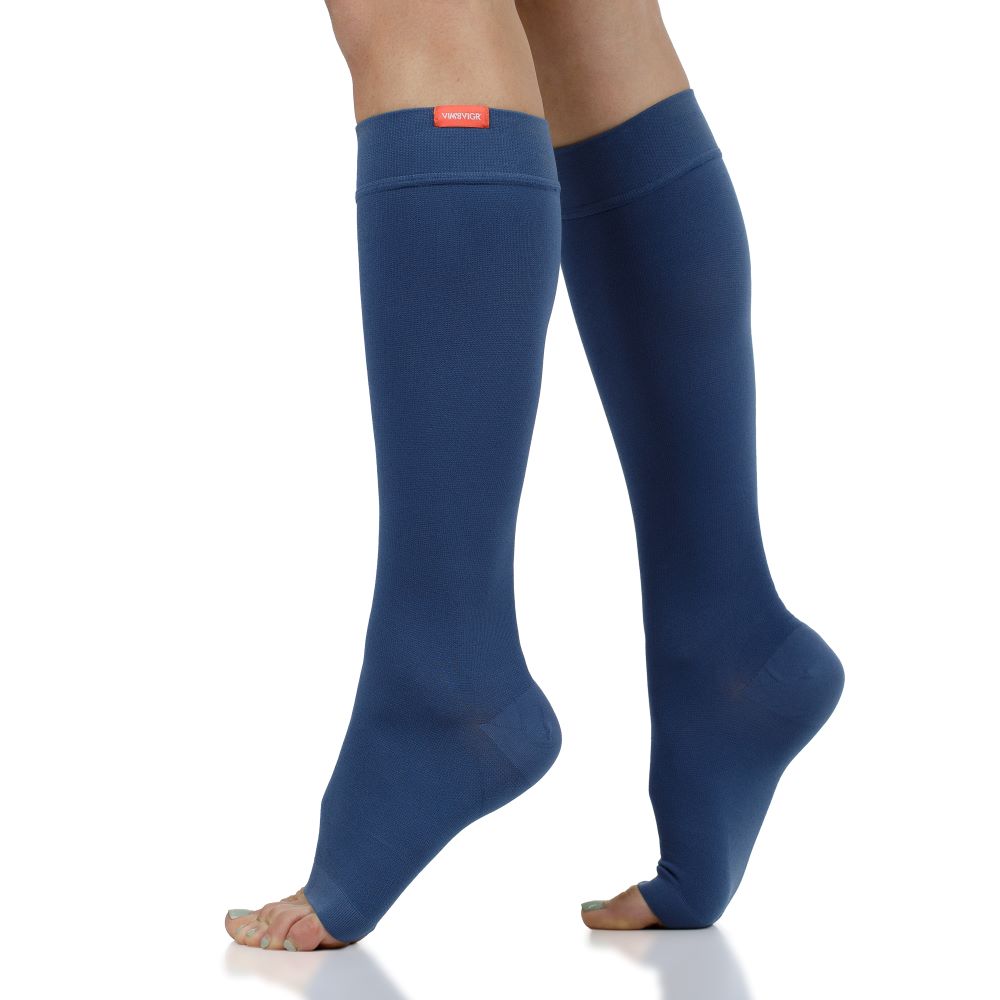Compression Socks for MS: Manage Symptoms & Find Relief
Multiple sclerosis (MS) is a debilitating illness. It can affect people in many ways, from vision problems to leg and arm movement, and beyond. Thanks to treatments and support from various specialists, there are ways to cope with many of the symptoms and improve a patient’s quality of life. Among these, compression socks can also play their part.
How do compression socks help patients manage MS symptoms and find relief? Thanks to the gentle support and massage applied to the lower limbs, these garments stimulate blood flow to reduce discomfort, swelling, and the risk of developing conditions related to the circulatory system. They also boost overall wellbeing and comfort and can support balance and mobility.
In this article, we’ll look at the benefits of compression socks for multiple sclerosis and provide some tips on making the most of wearing them.
Are Compression Socks Good for MS Patients?
Compression socks help with many MS symptoms, from leg swelling to tingling feet and general discomfort in the lower limbs. They can also be beneficial for balance and mobility.
MS causes mobility problems and can bring about spasms and muscle stiffness, but it’s also been linked to a high risk of cardiovascular and circulatory issues. These include the formation of blood clots, deep vein thrombosis, and venous insufficiency. Because graduated compression socks support lower limb blood flow and reduce the risk of these conditions developing, they can be of great help to MS patients.
Moreover, compression provides gentle massage that can relieve pain and reduce swelling and inflammation in the legs. MS often causes swelling, sometimes due to build-up of lymphatic fluid, because of reduced mobility. As compression socks squeeze the legs, they reduce any fluid leakage from tissues by increasing pressure in them. They are regularly recommended to people suffering from edema, after all.
Compression socks also help with other MS symptoms, such as tingling legs and feet, and provide reassuring support to the ankles and calf muscles through the tight grip they have on the lower legs.

The Benefits of Compression Socks for MS
While MS symptoms vary from person to person and can be unpredictable, there are a few common ones that occur repeatedly with patients suffering from this disease. In addition to medically prescribed treatments, compression socks can offer relief and help you manage some of these.
Reducing Fatigue and Weakness
An overarching symptom of MS is debilitating fatigue, which can be managed to some extent by keeping a healthy sleep schedule and endeavoring to stay active. Regular, moderate exercise helps re-energize patients and fights other MS side effects, like numb or tingling legs and balance and mobility problems.
Wearing compression socks during exercise provides support to the joints and muscles. It can also reduce the onset of fatigue by boosting blood flow to the legs, delaying soreness.
Improving Balance and Mobility
Many athletes returning to sports use compression socks, especially after calf sprains or Achilles tendonitis. This is because the snug fit and supportive material provide welcome added hold on the joints and muscles. This can feel more balancing for MS sufferers, helping them walk more confidently. Compression socks also feel supportive when you suffer from spasms and cramping, thanks to the massaging action on your muscles.
Enhancing Blood Flow and Circulation
A huge benefit of graduated compression socks is that they improve the blood flow in the lower legs. This reduces the risk of many circulatory problems and brings down inflammation and discomfort.
MS patients may be immobile for long periods of time if they feel sore and uncomfortable or weak. In these cases, compression socks will prevent blood clots and deep vein thrombosis from developing. They are often prescribed to post-surgery patients who are bed-ridden precisely for this reason.
Greater Comfort and Less Swelling
A healthy blood flow and an ongoing gentle massage to the legs ensure that MS patients can experience better levels of comfort thanks to compression socks. They play a role in reducing swelling, either from blood pooling in the legs or from excess lymphatic fluid. And they can help muscles recover after activity, so that patients can move around again and stay active.
Decreased Risk of Blood Clots
Poor peripheral circulation associated with MS can lead to blood clots. Left untreated, they can be life threatening. Because MS patients often experience impaired circulation, sometimes linked to reduced mobility, wearing compression socks can make up for their lack of movement and reduce the risk of blood clots.
Support for Venous Insufficiency
Venous insufficiency means that the walls of your veins are weakened and there is damage to the valves. This leads to the veins filling with blood which doesn’t move back towards the heart - an uncomfortable and dangerous situation.
People with MS can suffer from venous insufficiency as well, which can be addressed in part through wearing compression socks. The socks stimulate blood flow, reducing the risk of developing blood clots in the legs, and contribute to better circulation overall.
Understanding Multiple Sclerosis (MS)
Multiple sclerosis affects the brain and spinal cord, with the potential of causing serious levels of disability. Its symptoms vary widely and can be quite unpredictable, manifesting themselves differently in different people. However, the main symptoms of MS have been observed as:
- Fatigue;
- Difficulty walking;
- Impaired arm and leg mobility;
- Problems with eyesight;
- Spasms and muscle stiffness;
- Balance and coordination impairment;
- Numbness and/or tingling in different parts of the body.
Often, people suffering from MS have poor blood circulation, sometimes caused by reduced movement.

How Compression Socks Help with MS Symptoms
Thanks to their massaging action on the limbs and the fact that they stimulate blood flow, compression socks can be useful against pain and discomfort caused by MS. They offer relief from aches and swelling in the legs and they can provide additional support when walking, particularly for the ankles and calf muscles.
Compression garments stimulate blood flow in the area of the body where they are worn. Socks can therefore ensure that blood circulates freely in the lower limbs, bringing relief from tingling or numb feet and reducing inflammation. They also help prevent circulatory problems like venous insufficiency and blood clots.
Choosing the Best Compression Socks for MS
Getting all the benefits of compression socks for MS is easy if you pick the right pair for you. This needs to be in the most appropriate fabric and fit well. Here’s how to get this right.
Selecting the Right Compression Level
Compression socks come in various levels of compression - i.e., how tight they are. These are shown in mmHg and range from lighter, everyday wear, to pressure that is medically prescribed.
If you’ve never worn compression socks before and just want to try them out, possibly even wearing them all day long, then the 15-20 mmHg range of light compression socks is the best place to start. However, depending on your symptoms and other medical conditions, you could benefit from medium or high levels of compression, which can be very effective against conditions such as DVT. These are prescribed by a medical professional, so make sure to consult with your doctor.
Sizing Considerations
Compression socks need to be tight enough to work their magic on your legs. However, you don’t want socks that are so tight they cut off your circulation, either. And, if they’re too loose, you simply won’t see any benefit.
Use a sizing guide to understand how to measure your calf circumference and link this with your dress size to get the best fitting pair.
Material Options
Finally, there are lots of options for the best compression socks when it comes to fabric. Cotton is the tried-and-testesd, everyday material of choice. It fares well in any scenario and can be worn as long as you feel comfortable. However, it’s not particularly moisture wicking in hot weather.
We suggest wearing merino wool socks if you get cold feet or have poor peripheral circulation. This fabric is also hypoallergenic and thermoregulating, which means it allows feet to breathe in all weather conditions.
For a sleeker, more athletic feel, you can also choose nylon socks which are tighter, but also very flexible on the lower limbs. We also have a special moisture-wick nylon range for hot days.

Wearing Compression Socks for MS
Multiple sclerosis throws lots of challenges at patients and can be a very difficult condition to live with. It causes discomfort, pain, and reduced mobility. As we learn more about how to cope with its symptoms, various specialists can provide support on your MS journey. And, to help throughout, we can also recommend wearing compression socks for better blood flow and a gentle hug of your legs and feet.
Reducing the risk of circulatory problems and boosting your energy and comfort levels, compression socks play a small, yet effective role in managing MS symptoms. With this guide, you’ll be able to find the best pair for you.



















Leave a comment